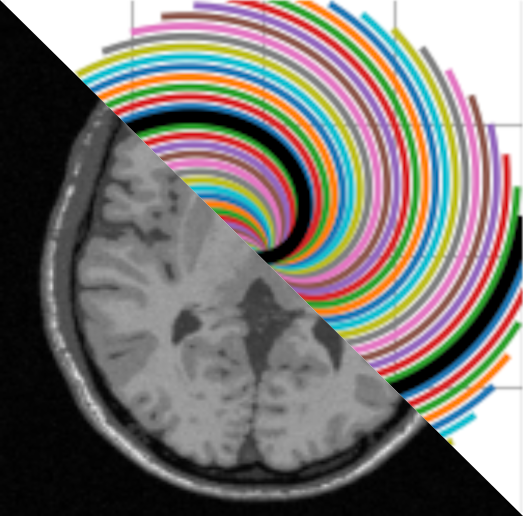4. Cartesian perodic under-sampling along parallel lines#
Here the goal is to illustrate the typical artifacts of standard deterministic regular (or periodic) undersampling along the phase encoding direction (here \(k_y\)) used in parallel imaging. Below we illustrate the following cases:
full Cartesian sampling \(R= n/m = 1\) where \(n=N^2\) is the image size, \(N\) the image dimension and \(m\) the number of measurements in k-space:
undersampling with a factor \(R=2\)
undersampling with a factor \(R=4\)
undersampling with a factor \(R=8\)
Author: Philippe Ciuciu (philippe.ciuciu@cea.fr)
Date: 06/24/2022
Date: 04/02/2025 (brainweb compatibility)
Target: IEEE EMBS-SPS Summer School on Novel acquisition and image reconstruction strategies in accelerated Magnetic Resonance Imaging
#DISPLAY BRAIN PHANTOM
%matplotlib inline
import numpy as np
import os.path as op
import os
import math ; import cmath
import matplotlib.pyplot as plt
import sys
from skimage import data, io, filters
import pywt as pw
import matplotlib.pyplot as plt
import brainweb_dl as bwdl
#Previousmly we used numerical phantoms
if 0:
cwd = os.getcwd()
dirimg_2d = op.join(cwd,"..", "data")
img_size = 512 #256
FOV = 0.2 #field of view in meters
pixelSize = FOV/img_size
#load data file corresponding to the target resolution
filename = "BrainPhantom" + str(img_size) + ".png"
mri_filename = op.join(dirimg_2d, filename)
mri_img = io.imread(mri_filename, as_gray=True)
plt.figure()
plt.title("Brain Phantom, size = "+ str(img_size))
if mri_img.ndim == 2:
plt.imshow(mri_img, cmap=plt.cm.gray)
else:
plt.imshow(mri_img)
plt.show()
plt.rcParams["image.origin"]="lower"
plt.rcParams["image.cmap"]='Greys_r'
mri_img = bwdl.get_mri(4, "T1")[70, ...].astype(np.float32)
#mri_img = bwdl.get_mri(5, "T2")[150, ...].astype(np.float32)
print(mri_img.shape)
img_size = mri_img.shape[0]
plt.figure()
plt.imshow(abs(mri_img))
plt.title("Original brain image")
plt.show()
/volatile/github-ci-mind-inria/gpu_mind_runner/_work/mri-acq-recon-book/mri-acq-recon-book/venv/lib/python3.10/site-packages/tqdm/auto.py:21: TqdmWarning: IProgress not found. Please update jupyter and ipywidgets. See https://ipywidgets.readthedocs.io/en/stable/user_install.html
from .autonotebook import tqdm as notebook_tqdm
(256, 256)
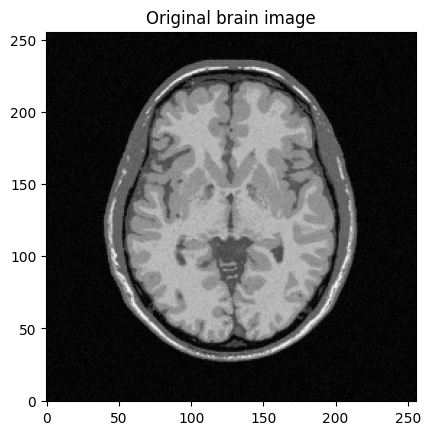
kspace_mask_full = np.ones((img_size, img_size), dtype="float64")
#import numpy.fft as fft
norm = "ortho"
def fft(x):
return np.fft.fft2(x, norm=norm)
def ifft(x):
return np.fft.ifft2(x, norm=norm)
# Generate the subsampled kspace with R=2
kspace_data = np.fft.fftshift(fft(mri_img)) # put the 0-freq in the middle of axes as
# Generate the kspace data: first Fourier transform the image
kspace_data = np.fft.fftshift(fft(mri_img))
#add Gaussian complex-valued random noise
signoise = 10
#kspace_data += np.random.randn(*mri_img.shape) * signoise * (1+1j)
# Simulate independent noise realization on the real & imag parts
kspace_data += (np.random.randn(*mri_img.shape) + 1j * np.random.randn(*mri_img.shape)) * signoise
# Mask data to perform subsampling
kspace_data *= kspace_mask_full
# Zero order solution
image_rec0 = ifft(np.fft.ifftshift(kspace_data))
fig, axs = plt.subplots(1, 3, figsize=(8, 8) )
axs[0].imshow(kspace_mask_full, cmap='gray_r')
axs[0].set_title("Full Cartesian mask (R=1)")
axs[1].imshow(np.abs(kspace_data), cmap='gray_r', vmax=.01*np.abs(kspace_data).max())
axs[1].set_title("Masked data")
axs[2].imshow(np.abs(image_rec0), cmap='gray')
axs[2].set_title("Cartesian recon")
Text(0.5, 1.0, 'Cartesian recon')
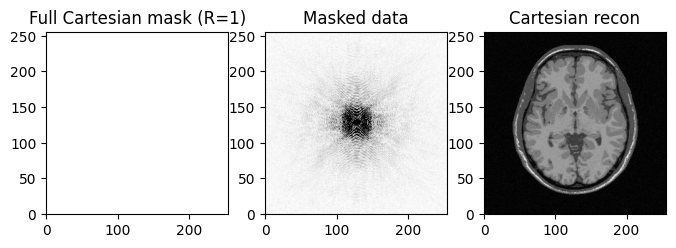
import numpy.matlib as mlib
# generate Cartesian lines in a straightforward manner
#a = (np.linspace(0,img_size,img_size+1))/img_size -0.5 # work in normalized frequency
r2 = (int)(img_size/2)
r4 = (int)(img_size/4)
r8 = (int)(img_size/8)
print("2-fold undersampling, m= ", r2)
print("4-fold undersampling, m= ", r4)
print("8-fold undersampling, m= ", r8)
selected_ksp_line = np.ones((1, img_size), dtype="float64")
skipped_ksp_line = np.zeros((1, img_size), dtype="float64")
k_space_pattern_r2 = np.concatenate((selected_ksp_line, skipped_ksp_line), axis=0)
kspace_mask_r2 = np.tile(k_space_pattern_r2, (r2, 1))
#k_space_pattern_r4 = np.concatenate((selected_ksp_line, skipped_ksp_line, skipped_ksp_line,skipped_ksp_line), axis=0)
k_space_pattern_r4 = np.concatenate((selected_ksp_line, np.tile(skipped_ksp_line, (3,1))), axis=0)
kspace_mask_r4 = np.tile(k_space_pattern_r4, (r4, 1))
k_space_pattern_r8 = np.concatenate((selected_ksp_line, np.tile(skipped_ksp_line, (7,1))), axis=0)
kspace_mask_r8 = np.tile(k_space_pattern_r8, (r8, 1))
fig, axs = plt.subplots(1, 3, figsize=(16, 16) )
axs[0].imshow(kspace_mask_r2) #, cmap='Greys_r'
axs[0].set_title("Cartesian regular under-sampling mask (R=2)")
axs[1].imshow(kspace_mask_r4, cmap='Greys_r')
axs[1].set_title("Cartesian regular under-sampling mask (R=4)")
axs[2].imshow(kspace_mask_r8, cmap='Greys_r')
axs[2].set_title("Cartesian regular under-sampling mask (R=8)")
2-fold undersampling, m= 128
4-fold undersampling, m= 64
8-fold undersampling, m= 32
Text(0.5, 1.0, 'Cartesian regular under-sampling mask (R=8)')

Generate undersampled data for \(R=2\) and perform image reconstruction
What do you observe?
# Generate the kspace data: first Fourier transform the image
kspace_data_r2 = np.fft.fftshift(fft(mri_img))
#add Gaussian complex-valued random noise
signoise = 10
# Simulate independent noise realization on the real & imag parts
kspace_data_r2 += (np.random.randn(*mri_img.shape) + 1j * np.random.randn(*mri_img.shape)) * signoise
# Mask data to perform subsampling
kspace_data_r2 *= kspace_mask_r2
# Zero order image reconstruction
image_rec0_r2 = ifft(np.fft.ifftshift(kspace_data_r2))
fig, axs = plt.subplots(2, 2, figsize=(10, 10) )
axs[0,0].imshow(mri_img, cmap='Greys_r')
axs[0,0].set_title("True image")
axs[0,1].imshow(kspace_mask_r2, cmap='Greys_r')
axs[0,1].set_title("Sampling mask")
axs[1,0].imshow(np.abs(kspace_data_r2), cmap='gray', vmax=0.01*np.abs(kspace_data_r2).max())
#axs[1].imshow(np.abs(np.fft.ifftshift(kspace_data)), cmap='Greys_r')
axs[1,0].set_title("k-space noisy data (R=2)")
axs[1,1].imshow(np.abs(image_rec0_r2), cmap='gray')
axs[1,1].set_title("Zero-order recon")
plt.show()
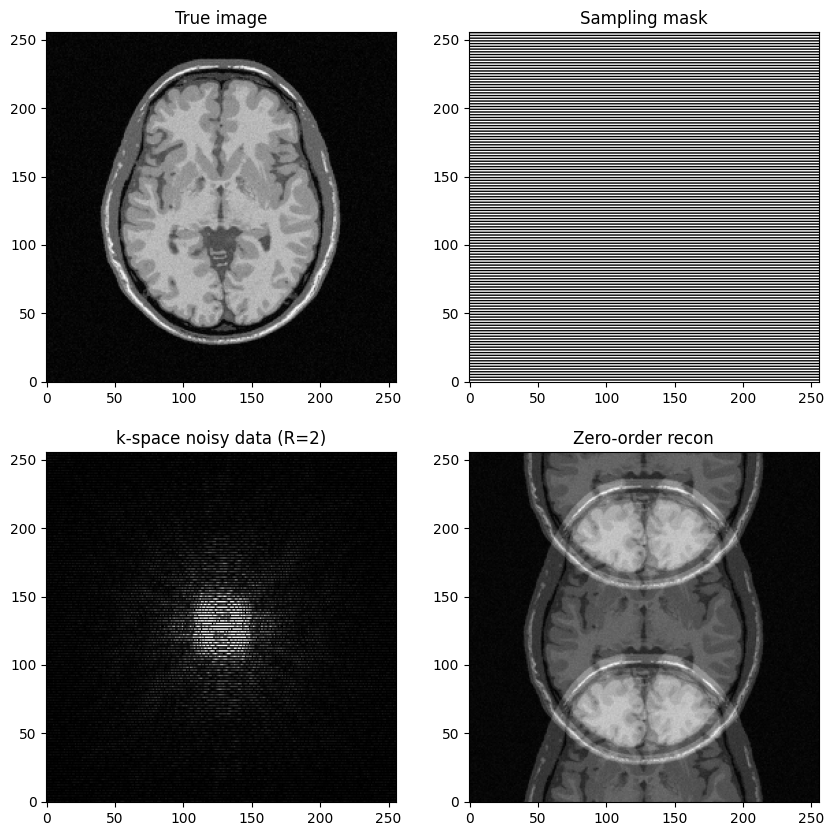
Generate undersampled data for \(R=4\) and perform image reconstruction
What do you observe?
# Generate the kspace data: first Fourier transform the image
kspace_data_r4 = np.fft.fftshift(fft(mri_img))
#add Gaussian complex-valued random noise
signoise = 10
# Simulate independent noise realization on the real & imag parts
kspace_data_r4 += (np.random.randn(*mri_img.shape) + 1j * np.random.randn(*mri_img.shape)) * signoise
# Mask data to perform subsampling
kspace_data_r4 *= kspace_mask_r4
# Zero order image reconstruction
image_rec0_r4 = ifft(np.fft.ifftshift(kspace_data_r4))
fig, axs = plt.subplots(2, 2, figsize=(10, 10) )
axs[0,0].imshow(mri_img, cmap='Greys_r')
axs[0,0].set_title("True image")
axs[0,1].imshow(kspace_mask_r4, cmap='Greys_r')
axs[0,1].set_title("Sampling mask")
axs[1,0].imshow(np.abs(kspace_data_r4), cmap='gray', vmax=0.01*np.abs(kspace_data_r4).max())
axs[1,0].set_title("k-space noisy data (USF=2)")
axs[1,1].imshow(np.abs(image_rec0_r4), cmap='Greys_r')
axs[1,1].set_title("Zero-order recon")
plt.show()
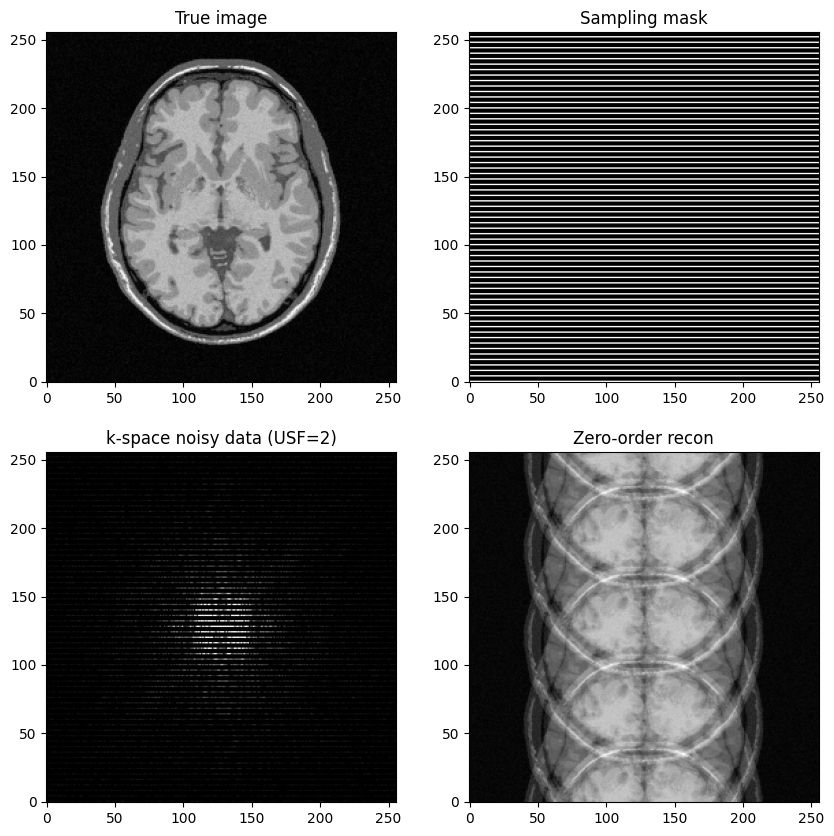
Generate undersampled data for \(R=8\) and perform image reconstruction
What do you observe?
# Generate the kspace data: first Fourier transform the image
kspace_data_r8 = np.fft.fftshift(fft(mri_img))
#add Gaussian complex-valued random noise
signoise = 10
# Simulate independent noise realization on the real & imag parts
kspace_data_r8 += (np.random.randn(*mri_img.shape) + 1j * np.random.randn(*mri_img.shape)) * signoise
# Mask data to perform subsampling
kspace_data_r8 *= kspace_mask_r8
# Zero order image reconstruction
image_rec0_r8 = ifft(np.fft.ifftshift(kspace_data_r8))
fig, axs = plt.subplots(2, 2, figsize=(10, 10) )
axs[0,0].imshow(mri_img, cmap='Greys_r')
axs[0,0].set_title("True image")
axs[0,1].imshow(kspace_mask_r8, cmap='Greys_r')
axs[0,1].set_title("Sampling mask")
axs[1,0].imshow(np.abs(kspace_data_r8), cmap='gray', vmax=0.01*np.abs(kspace_data_r4).max())
axs[1,0].set_title("k-space noisy data (USF=2)")
axs[1,1].imshow(np.abs(image_rec0_r8), cmap='Greys_r')
axs[1,1].set_title("Zero-order recon")
plt.show()
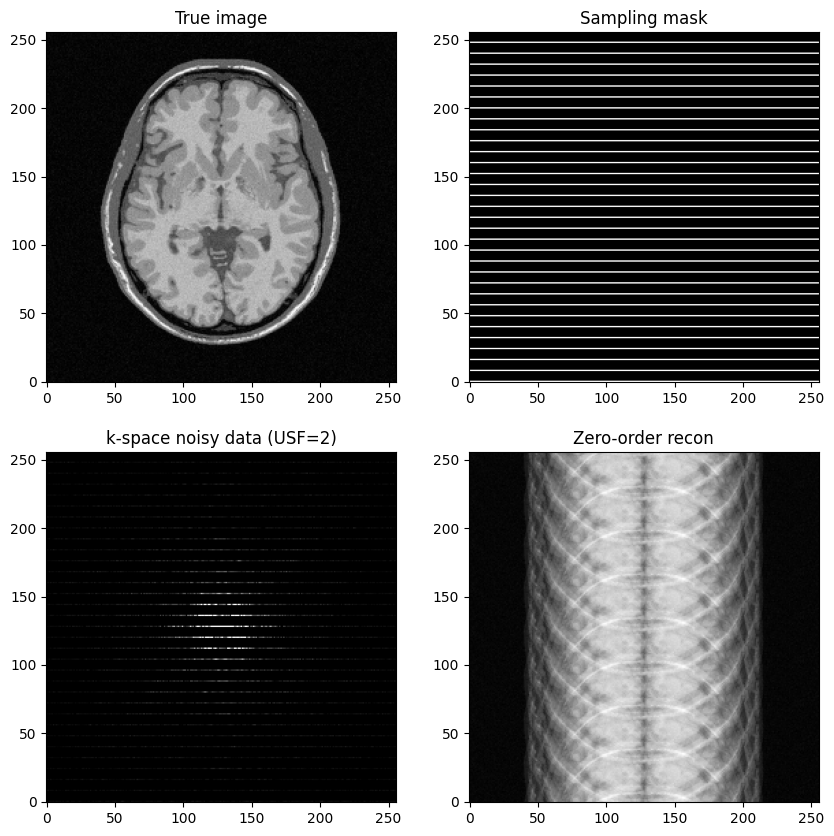
- Do you know what key ingredient may help to recover the reference image pretty well while still using these regular under-sampling patterns?
